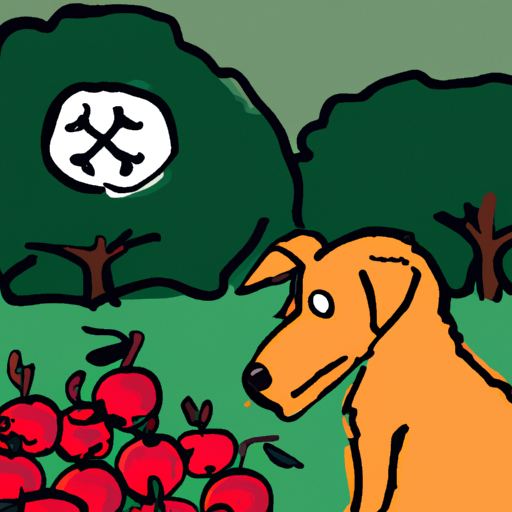Understanding Crab Apples
The crab apple, scientifically known as Malus, is a genus of about 30–55 species of small deciduous apple trees or shrubs in the family Rosaceae. They are native to the temperate zone of the Northern Hemisphere. While they are not the typical apples we’re used to seeing in grocery stores, they are indeed a type of apple. They are smaller and usually have a more tart or bitter taste.
The main concern when it comes to dogs and crab apples isn’t the fruit itself. It’s the seeds, stems, and leaves that contain a natural chemical (amygdalin) that can release cyanide when digested. However, a dog would have to eat several pounds of these parts to reach a toxic level.
Identifying Signs of Cyanide Poisoning in Dogs
Just as with any potential toxin, it’s important for you as a caregiver to know what to look for. Cyanide poisoning can cause a range of symptoms in dogs, including:
- Difficulty breathing
- Panting
- Skin irritation
- Dilated pupils
- Excessive drooling
- Vomiting
- Tremors
- Loss of appetite
If your dog displays any of these signs after ingesting crab apple parts, it’s essential to get them to a vet as soon as possible.
Preventing Crab Apple Poisoning in Dogs
The best way to prevent crab apple poisoning in your dog is to keep them away from the trees altogether, especially during the fall when apples are falling from the trees. Here are some tips to ensure your pet’s safety:
- Always supervise your dog when they are outside, especially during the fall season.
- If you have a crab apple tree in your yard, consider fencing it off to prevent your dog from getting to it.
- Regularly check your yard for fallen apples and remove them promptly.
- If your dog shows interest in the crab apple tree or fallen apples, redirect their attention to a toy or treat.
What If My Dog Eats a Crab Apple?
In most cases, a dog eating a crab apple won’t cause any major issues. The fruit itself is not harmful to dogs. However, if your dog eats the seeds, stems, or leaves, they could potentially ingest enough cyanide to become sick.
If your dog eats a crab apple or part of a crab apple tree, monitor them closely for any signs of illness. If they start to show any symptoms of cyanide poisoning, take them to the vet immediately.
| Symptom | Action |
|---|---|
| Difficulty breathing | Take to the vet immediately |
| Panting | Monitor closely |
| Skin irritation | Bathe your dog |
| Dilated pupils | Monitor closely |
| Excessive drooling | Offer water, monitor |
| Vomiting | Offer water, monitor |
| Tremors | Take to the vet immediately |
| Loss of appetite | Monitor, offer tempting food |
FAQs
Q: How much cyanide is in a crab apple?
A: The exact amount of cyanide in a crab apple tree can vary based on the specific species and the part of the tree. The seeds, stems, and leaves contain the most cyanide.
Q: How many crab apples would a dog have to eat to get sick?
A: It’s difficult to say exactly how many crab apples a dog would have to eat to get sick. However, a dog would likely have to eat several pounds of the seeds, stems, or leaves to ingest a toxic dose of cyanide.
Q: What should I do if my dog eats a crab apple?
A: If your dog eats a crab apple, monitor them closely for any signs of illness. If they start to show any symptoms of cyanide poisoning, take them to the vet immediately.
Q: Can I feed my dog crab apples?
A: While the fruit of the crab apple is not toxic to dogs, it’s best to avoid feeding them to your dog due to the risk of them ingesting the seeds, stems, or leaves.
Q: Are there any benefits to dogs eating crab apples?
A: Crab apples are high in fiber and vitamin C, but they are not a necessary part of a dog’s diet. It’s best to stick to dog-safe fruits like bananas and apples (without the seeds).



